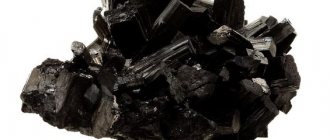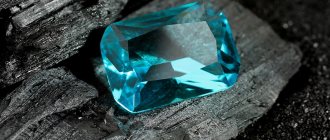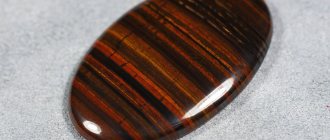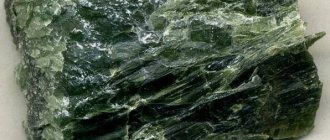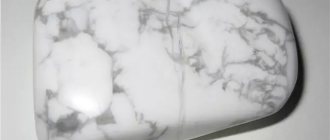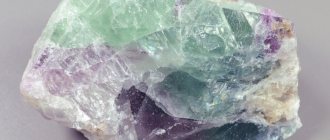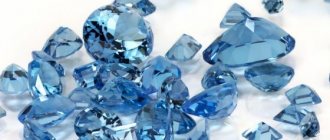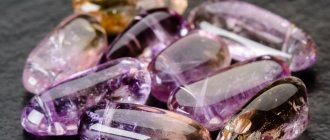- about the author
- Recent publications
More details
Pythia
Administrator at Pifiya.ru
Hello our dear reader! Today you are visiting Pythia. We invite you to immerse yourself in the study of the subtle world, the world of the unknown and unknowable, what in the concept of Don Juan is called the Nagual...
More details
Pythia recently published (see all)
- The icon on the way helped. Mystical story - 12/23/2021
- Prophet of troubles. Mystical story from life - 12/11/2021
- Through the Looking Glass. Mystical story - 12/10/2021
Since time immemorial, the history of mankind has been connected with this amazing stone - amber. Amber is a stone that stands apart from other stones, differing from them both in its physical properties and magical properties. And this is not surprising, because the stone is of organic origin, it is a hardened fossil resin. But for many, many years, humanity did not suspect this. And the imagination of the people gave birth to numerous romantic legends explaining the origin of this wonderful stone.
Amber - the stone of the Gods
In Ancient Greece, amber was considered the frozen tears of the heliades turned into poplars, the faithful nymphs of Phaethon's mother Clymene. When Phaeton could not cope with the solar chariot of his father, the god Helios, and Zeus smashed the chariot with lightning, Phaeton fell and died. And over his grave, Phaethon’s mother Clymene and the Heliades, who had become poplars from grief, wept.
Already the ancient Greeks suspected the plant origin of amber and clothed their knowledge in a poetic myth.
The ancient Lithuanians have a similar legend. It tells about the love that the goddess of the sea Jurata inflamed for a young fisherman. She took her beloved to the underwater kingdom and spent time with him in her palace. But having learned about this connection, the supreme god Perkunas was angry with Jurata, and struck the fisherman with lightning. The unfortunate Jurata cries over the body of her beloved, and the sea throws out her tears in the form of pieces of amber.
Latvia has its own legend about the origin of the gem. Its heroine is the mythical bird Gauja, who kept a beautiful necklace of golden-yellow stones in her nest. But the servant of the greedy king stole the necklace and took it on a boat across the sea. She flew at the thief Gauya and lifted him into the sky and threw him into the sea. The necklace crumbled, the beads sank, and a beautiful underwater forest grew from them. Underwater trees reach towards the sun, but cannot reach the surface, and therefore cry amber tears.
Many peoples have similar legends about the mineral and this is not surprising. This stone is too unusual and beautiful to get lost among other stones.
ORIGIN
The initial act in the formation of amber was the abundant release of resin from conifers. The reasons for it are very diverse. The main one should be considered a sharp warming of the climate. Pines were also sensitive to external influences. During thunderstorms, hurricanes and similar phenomena, they secreted resin-sap, which had a protective function: quickly hardening, the resin dried on the affected area, protecting the tree from infection through the wound. The bulk of the resin flowed from trees broken during the spring windbreaks. Resin flowed no less abundantly when various forest pests gnawed, pierced and gouged the bark. The trees were forced to heal the wounds inflicted on them. Thick sticky resin formed nodules, clots, clusters, and drops on the trees, which, unable to withstand their own weight, fell to the ground. Sometimes the resin release process was interrupted and resumed after some time, which contributed to the formation of multilayer resin secretions. Insects landed on the resin and stuck to it. Unable to free themselves from the sticky mass, they remained in it forever.
At the second stage, the resin was buried in forest soils. It was accompanied by a number of physicochemical transformations of the resin, the nature of which largely depended on the conditions in which the resin was exposed. In dry, well-aerated soil, the resin was transformed with the participation of oxygen. The resin's stability increased and its hardness increased. In wetlands, in anaerobic conditions, the resin retained its brittleness.
The third stage in the formation of amber is marked by erosion, transfer and deposition of fossil resins into the water basin. Conditions favorable for the emergence and accumulation of amber are associated with the geochemical and hydrodynamic specifics of the basin.
The transformation of resin into amber occurs with the participation of oxygen-containing, potassium-enriched alkaline silt waters, which, when interacting with the resin, contribute to the appearance of succinic acid and its esters in it. At the final stages of this process, not only amber is formed, but also glauconite, a mineral that constantly accompanies amber accumulations, i.e., the transformation of fossil resin into amber and the formation of glauconite occur in the same redox environment. The discovery of glauconite is evidence of a slightly alkaline and slightly reducing environment. The absence of this mineral in the rock is further evidence of intense aeration of sediments.
Types of amber
Amber is also an amazing stone because in nature there are several dozen of its varieties, differing from each other in color and density, but similar in origin - they all owe their birth to the resin of trees that grew millions of years ago.
The largest deposits of the mineral are located in the Baltic Sea region, and the Baltic countries are the world leaders in the extraction of this stone. Mexico boasts the second largest amber deposit.
Amber comes in different colors, and experts are able to distinguish up to 350 shades. Light yellow, golden, and orange shades predominate among them; these colors can be called classic for stone.
But there is also amber in white, blue, red and even black.
The gem also differs in its degree of transparency. There are individual voids in transparent amber, but their number is extremely small. There are more voids in a translucent stone, and they lead to the formation of cloudiness. This is how the Cloud and Bastard amber varieties appear. And finally, opaque - has a huge number of internal voids and is called bone or foam.
In addition to voids, amber is famous for inclusions or inclusions of foreign bodies. Such inclusions can be foreign objects, grains of sand, blades of grass, twigs, and even living beings preserved millions of years ago - insects. There is a piece of amber in which a whole lizard was discovered.
Amber Rainbow
After much debate about which mineral is considered amber and which is not, geologists and gemologists around the world agreed that this can be called any plant resin fossilized in the depths, which is at least 1 million years old. In this case, the type of tree to which the resin belongs does not matter. Thus, at present there are several hundred deposits where amber of a wide variety of shades is mined.
The most common type of gemstone of jewelry value is succinite. It is the product of fossilization of fossil plants related to modern pine trees. The most common variety, “batter,” has jewelry value. The classic description of amber fits it: transparent, golden yellow, cognac or honey tones.
Silver ring DARWIN with amber (go to the SUNLIGHT catalog)
In European deposits it is accompanied by gedanite, which is often found on the beaches of the Baltic states. The mineral has all the magical properties of amber, which are also inherent in other varieties. Jewelers call this variety “rotten”. It is not suitable for making beautiful and expensive products and is more often used as an ornamental raw material.
Amber, the color of which is heterogeneous and consists of white, dark and golden stains, is usually called landscape. The design on the polished cabochon truly resembles a painting depicting a fairytale location. This material is considered one of the most popular types of jewelry on the market, since each product with a gem insert is truly unique.
The royal variety, which is completely opaque and has a noble ivory shade, is also highly prized. This effect occurs due to microscopic air bubbles enclosed in the thickness of the resin. Another similar variety is called cloud stone. The bastard variety is more transparent than the royal variety, there are significantly fewer gas bubbles in it, they are located unevenly and form picturesque patterns reminiscent of swirling clouds.
White varieties in Ancient Rome had a very low price in jewelry, but were widely used as incense. Pieces of resin burning in the incense burners of temples filled the air with fragrant smoke, which was intended to convey people’s requests to the gods. Milk amber was also used to make medicines: powders for abdominal pain, hemostatic drugs, and heart medications. It has now been established that these stones contain the highest content of succinic acid, a natural biostimulant that has many beneficial properties.
On about. Sicily, North Africa, Japan and Burma have deposits where an unusual cherry-colored gem is mined. There is no consensus on why nature gave the stone this color. Some believe that the culprit is the conditions in which the resin was located for a long time, others believe that the reddish substance was the substance itself, flowing from prehistoric trees.
Blue and green - like the sea
It turns out that there are quite unusual types of gems. On the islands of the warm Caribbean Sea, amazingly colored stones are mined. For all varieties there is a common name - Dominican amber. But it is impossible to find even 2 samples similar to each other: in the thickness of the massif, blue amber resembles the color of the water surrounding the islands, and individual pieces of stone, polished for making products, have inclusions and veins of a golden color, similar either to sandy beaches or underwater shallow.
Silver brooch with amber
Some fragments have a mixed tint. Green amber is beautiful in its own way: imperceptible transitions of tones from bluish to yellowish, inclusions of gold “placers” make it look like a sea, constantly changing its appearance.
The green and blue colored gemstone is considered one of the most expensive varieties of the mineral. Greenish, swampy, grayish stones are found quite often, but they cannot be compared with those that are mined in the few Caribbean mines. The secret lies in the quality of the plant resin from which blue amber is formed. Most likely, it acquired a magical color under the influence of some local conditions that could not be repeated anywhere else. An aromatic substance, perylene, was found in the fossilized resin. Thanks to the properties of its large molecules to refract ultraviolet rays in a special way, making it visible, the colorless resin acquires a blue glow. Thanks to this optical effect, blue amber acquired its extravagant appearance. A similar mineral of the same rare color is also mined in the same mines.
Silver earrings with amber (go to the SUNLIGHT catalog)
Green amber has long been found in many other places. Usually these stones have only a slight hint of green or have marsh and bottle tones. The coloring of Dominican varieties is provided by the same perylene. When heated in an oxygen-free environment, the structure of the mineral changes. Transparent resin begins to transmit only yellow and blue rays of the solar spectrum. When reflected, they mix, creating rich shades of green.
Blue amber differs from European varieties in its smell. The coniferous aroma characteristic of northern varieties of stone, which can be felt when burned, is uncharacteristic of Dominican gems. They have a light floral hue reminiscent of tropical summer. This is the smell of carob resin, the closest relative of those extinct plants whose “tears” were preserved by the land of distant islands.
Application of amber
Most often we come across amber, which is used as jewelry. It is used to make beads, bracelets, earrings and rings, pendants and brooches. Any decoration with a sunstone makes it sparkle and attract the eye, and therefore amber jewelry is very loved by women. Souvenirs are made from it, from ordinary keychains to chess and dishes. The gem is also used to decorate the interior. Everyone remembers the history of the Amber Room, one of the greatest treasures of all mankind.
But amber is also used for other, purely practical purposes.
Amber oil and amber powder are used in medicine and cosmetology. The oil is used for rubbing and massage, and the powder is also used to make candles and tooth powder. Amber infusions and decoctions are widespread in folk medicine.
Amber varnish is used in the manufacture of musical instruments, amber oil is used to make threads, and succinic acid is used in agriculture to treat seeds.
Amber is also widely used for magical purposes. This solar stone can bring good luck and tranquility, protect against negative influences, increase health and overcome depression.
Amber has always been used as a powerful magical amulet and for harmonizing planets in the horoscope. This is only a small part of the possibilities that this unique stone can open up.
Amber amulets protect the home from natural disasters and attacks by intruders, bring calm to dreams, help pregnant women give birth safely, comfort them in grief, clarify thoughts and clear the space of negative energies.
This is interesting
- In the 19th century, two pieces of amber weighing 12 and 9.7 kg were found in Prussia.
- The Kaliningrad Regional Amber Museum houses the largest sample of amber in Russia, weighing 4.28 kg.
- One of the largest samples that were found is the Burmese mineral. Its weight is 15.25 kilograms, and the stone itself is kept in a London museum.
- The price depends not only on the color and size, but also on the presence of inclusion. The most expensive amber is a pebble with creatures frozen inside (spiders, butterflies, snails, lizards or frogs). Its price can reach several tens of thousands of dollars.
- There are 3 stones known in the world whose cost exceeds 10 thousand dollars: in the first there is a chameleon 7 cm long, in the second there is a lizard 10 cm long, in the third you can see a frozen frog.
- The famous Amber Room was made for the Prussian king Frederick I, and then became the property of Peter I. During the Great Patriotic War, the room was transported to Tsarskoye Selo, and then disappeared without a trace during the occupation. According to some reports, it was transported secretly by the Germans, but some are convinced that the unique treasure burned down.
Sources and literature
- Amber // Explanatory dictionary of the Russian language (compiled by S. I. Ozhegov, N. Yu. Shvedova). - M., 1992
- Gladky V.D. Amber / Ancient world // Encyclopedic dictionary in 2 volumes. — M.: Tsentrpoligraf. 1998.
- Kostyashova Z.V. Baltic gem // Science and life. - 1999. - No. 5. - P. 43.
- Amber // Geological Dictionary: in 2 volumes / Edited by K. N. Paffengoltz and others. - M.: Nedra, 1978.
- Zoya Kostyashova. “Under the sign of Leo” // Kaliningradskaya Pravda: newspaper. - Kaliningrad, 1998. - August 8. — P. 6.
- Bogdasarov M. A., Bushnev D. A., Golubev E. A., Kovaleva O. V., Shanina S. N. Amber and amber-like fossil resins of Eurasia: Parts 1-2. // News of universities. Geology and exploration, 2008: Part 1: Infrared spectrometry, differential thermal analysis. No. 4. P. 23-30; Part 2: Pyrolytic gas chromatography, gas chromatography-mass spectrometry, amino acid analysis, electron and atomic force microscopy. No. 5. pp. 27-32.
- Loze I. A. Late Neolithic and Early Bronze Age of the Luban Plain. - Riga, 1979.
- Savkevich S. S. Yantar. - L.: Nedra, Leningrad branch, 1970. - 191 p. — 1700 copies.
- Amber on Wikipedia ru.wikipedia.org
5 / 5 ( 14 votes)
Amber and love
One of the most important properties of the mineral is its ability to harmonize the relationship between a man and a woman. In ancient times, it was called the stone of love and various love talismans were made from it.
Thanks to its ability to give its owner joy and tranquility, the stone has a positive effect on any relationship, prevents people from quarreling over trifles, and puts them in a positive mood. Amber enhances sensual attraction, which helps people maintain the strength of their feelings for many years.
This stone has the unique property of attracting the gaze of representatives of the opposite sex, making a woman irresistible, bright, and attractive. A woman wearing jewelry and amulets made of sunstone is always the center of attention; she shines not only with external beauty, but also with eloquence and intelligence.
Color spectrum
Samples of amber from the Museum of the World Ocean
It is not without reason that amber is called the sun stone. Its classic color scheme is yellow-brownish. There are other shades and types of mineral. The structure and color of amber were created by natural factors of the period when conifer resin flowed onto the soil. From it the organic mineral was formed. The longer the pebble was in the sun or air, the brighter it is.
Gemologists and mineralologists have classified more than 300 colors and shades of gems - from white to black:
- yellow-brown is the most common;
- orange;
- red or the color of ripe cherry - called “dragon’s blood”, similar to a ruby, very rare, expensive;
- white - actually yellowish in color, the illusion of white color is created due to bubble inclusions;
- green - the color of the stone comes from sulfur pyrites or algae;
- colorless - transparent waxy mineral;
- blue—Dominican amber;
- black - dull-opaque, also known as jet.
Amber and money
Most psychics believe that amber itself is not capable of attracting wealth to a person, except perhaps indirectly. After all, the sun stone has another interesting property: it can attract beautiful, antique and expensive things. As a rule, the purchase of even one amber jewelry entails the purchase of other things, especially antiques. And antiques are a good financial investment, and guarantee their owner a certain financial well-being and increase his well-being.
However, a number of psychics believe that money amulets can be created from gems using special money spells. Amber easily absorbs any magical spells and energy flows, but whether after such a spell it will become an effective amulet is a moot point.
Here is an example of such a wealth plot for amber:
On the waxing Moon, the purchased gem should be placed in the moonlight and, stroking the stone counterclockwise, repeat:
Amber, amber, burn in the moonlight, bring wealth to my wallet.
Historical reference
Mechanical watch with a rotating dial, in an amber case.
Human use of amber has been known since ancient times. It has been established that amber was known to Upper Paleolithic man: pieces of amber were found inside a dwelling of that time in Mezhirich (Dnepropetrovsk region of Ukraine).
The French name for amber (ambre) was borrowed from Arabic (ʿanbar عنبر). The Arabs considered the stone to be hardened dew that fell from the sky. After its transformation into amber, the word entered many modern Romance and Germanic languages.
Actually, the word “amber” (in the form “entar”), probably borrowed from the Lithuanian language (lit. gintaras), has been known in the Old Russian language since the middle of the 16th century (first attested in 1551). Ukrainian (as a synonym for the word burshtin), Czech, Serbo-Croatian and Slovenian names for amber are already borrowed from Russian.
It has many poetic names - “tears of the sea”, “gift of the sun”, etc.
In ancient times, Aristotle, and after him Theophrastus and Pliny the Elder, assumed that the formation of this stone was associated with the resin of coniferous trees.
In the 18th century, the Swedish naturalist Carl Linnaeus and the Russian scientist Mikhail Lomonosov scientifically proved that amber actually comes from the resin of ancient coniferous trees. M. V. Lomonosov presented new arguments in favor of the organic origin of amber in his works “The First Foundations of Mining Science” and “The Word on the Birth of Metals from Earth Shaking.”
The scientific description, origin and classification of amber (white amber, yellow amber) was given in 1807 by academician Vasily Severgin in the book “Detailed Mineralogical Dictionary”.
Amber for health
Amber has a powerful ability to protect and heal the human body from various diseases. An important role in this is played by the fact that the mineral itself is of organic origin, and its composition includes microelements necessary for normal health such as iodine, iron, zinc, magnesium, calcium and a number of others.
Therefore, for many centuries people have been using amber to treat diseases of the thyroid gland, cardiovascular system, varicose veins, and colds. It stimulates the human immune system and can even help fight tumors.
With the help of amber, people sought to control weight, because it improves metabolic processes in the body, gets rid of the effects of intoxication, and stimulates brain activity. Amber crumb is included in a number of drugs that help with colds and lung diseases. And the smoke of the mineral has always been used to prevent and treat asthma.
The best effect from using amber occurs when wearing it in open jewelry touching the human body - beads, bracelets, earrings.
Physical and chemical properties
Ancient insects in amber
Amber is the hardened resin of coniferous trees. This is an amazingly beautiful stone of natural origin: its physical characteristics differ from other organic minerals.
Amber does not form crystals; it is an amorphous framework polymer. Easy to polish.
Birefringence, dispersion, and pleochroism are absent.
The absorption spectrum cannot be interpreted. Luminescence is bluish-white to yellow-green, in birmite it is blue.
Electrified by friction (negative charge).
Flammable - ignites from the flame of a match. In the open air, it actively oxidizes (aging), which over time leads to changes in the chemical composition, color, and increased fragility.
| Formula | C10H16O+(H2S) |
| Color | Light yellow, brown, red, milky white, greenish |
| Shine | Smolyanoy |
| Transparency | Variable: from almost transparent to completely opaque |
| Hardness | 2-2,5 |
| Cleavage | Absent |
| Kink | Conchoidal; viscous (becomes brittle with aging) |
| Density | Typically 1.05-1.09, maximum 1.3 g/cm³ |
How does Amber feel in silver and gold?
Amber is also unique in that it makes absolutely no difference to it whether it is in any kind of frame or without one at all. The gem is in perfect harmony with gold and silver, platinum and other metals. Not only that, it goes well with other gemstones, wood and plastic. None of these materials degrades any properties of the stone.
And of course, amber can do just fine without any setting, because its best properties are found inside the stone itself. Many psychics believe that a nugget without a frame is best suited for creating magical amulets and saturating them with the necessary energy.
But in expensive jewelry, a frame is still necessary, because it is a soft stone and the frame plays the role of protecting it from damage.
Who will benefit from the stone?
Earrings with large faceted drops of amber and hessonites from Lilly Hastedt
Amber is a unique link between the past and the present, a keeper of the memory of times distant and almost inaccessible to study. That is why the stone is considered the most successful talisman for those whose life and work are directly related to the study of bygone days - archaeologists, geologists, philosophy teachers and historians.
Advertising - Continued below
How to cleanse Amber from foreign energy
It is known that any stone is capable of remembering information, including negative information, and thereby influencing the biofield of its owner. The more people who wore the stone before you, the stronger the energetic trace they left in the stone and the sooner the stone should be cleansed of this energy. Even the positive energy accumulated in a stone can be useless and harmful if it does not harmonize with the personal energy of the owner.
Amber perceives magical energy better than most other stones. Sometimes just holding the stone for a couple of minutes is enough to fill it with negative energy. Therefore, it is especially important for amber to carry out its energetic cleansing immediately after acquisition.
One of the easiest ways to clean amber is to clean it with sunlight. It is not for nothing that it is called the sun stone, and it is the energy of the sun that harmonizes most well with the internal structure of the stone.
To clean amber with sunlight, you should first rinse the stone under running water, first warm, then cold, and then leave it on the windowsill for an hour. This procedure should be repeated several days in a row. You should not leave the gem for a very long time in the sun’s rays, because the stone can “burn out” if it is oversaturated with the energy of the sun.
Bakelite, buranite, celluloid and epoxy resin
Precious stones have always been counterfeited. Even in ancient Rome, inexpensive yellow amber was boiled in honey. This gave it the rich reddish-brown color of noble varieties. Such gems were much more expensive, and the demand for them was quite high.
In the 18th century, another technology was invented: waste from amber jewelry processing (dust, crumbs, etc.) could be mixed with ordinary, fresh pine resin and compressed when heated to a high temperature. The cherry shade of faturan (that was the name of the new material) could compete in beauty with Sicilian gems, which were highly valued.
The inventor of phenol-formaldehyde resin, L. Backland, gave scammers a new way to fake amber: the plastic he created, after coloring, was very reminiscent of Baltic gems. And for this it was only necessary to slightly disrupt the technology and add some substances to the plastic melt. The market is flooded with cheap and beautiful jewelry. Even the leaders of the world-famous pen could not resist the beauty of the material - the bodies of high-quality pens began to be made from bakelite, very similar to amber.
Celluloid was originally created as a replacement for ivory. But imitation amber made from this plastic is still in demand. Handles for knives and forks are made from it, an inexpensive decoration for various purposes. Jewelry is extremely rarely counterfeited, since upon closer inspection the differences from natural material are striking.
Acrylic fakes are much more common, and polyester compounds gave the world such materials as bernite and buranite. Depending on the processing conditions, the material can have the green shades of expensive Caribbean varieties, the red color of Sicilian stone, and the usual honey-yellow and cognac tones of the Baltic types. Even the rare blue stone is counterfeited by painting artificial resins in the appropriate colors.
How to distinguish a fake?
The simplest thing is to weigh it. Beads made from real amber, about 40 cm long, can weigh less than 100 g, depending on the size of the elements. Any artificial material (including blue amber) has a much greater mass. But one should also be wary of the relatively low price or the ease with which the merchant lowers the price.
Silver necklace with amber in the SUNLIGHT catalog
It is unlikely that the seller will allow the buyer to scratch or set fire to his product to check its naturalness. But you can also warm up the stone by rubbing it against a cloth or your own palm. When heated, natural material emits the smell of pine resin, pine needles or turpentine. Synthetics have a very characteristic aroma that is difficult to confuse with coniferous.
In a jewelry store, you can ask the seller for an ultraviolet lamp (a device for checking banknotes). In its light, the structure of a real stone becomes visible: uneven deposits of resin, stripes of varying transparency. White and cloudy varieties acquire a bluish glow created by the refraction of rays in gas bubbles, while rough semi-precious stones of dark varieties glow red-brown. Plastic counterfeits do not exhibit luminescence.
Silver earrings with amber
None of the described methods will help to distinguish inexpensive varieties of amber that have been heated. This is done to change its color to imitate a more expensive gem. As a rule, in an array of such stones, scales or sparkles are visible, formed as a result of the expansion of gas bubbles. Green amber obtained by heating also has a not very pleasant, swampy tint.
How to add magical power to a stone?
Amber has a very high affinity for magical energy; it perfectly accumulates both magical energy and information, and therefore at all times amber has been the favorite stone of magicians and psychics. Oddly enough, even the church recognizes the special magical powers of amber and uses this stone for its own purposes. Even Patriarch Nikon had an amber staff, and ordinary priests fumigated people with amber to protect them from evil spirits and the evil eye.
Amber accumulates the energy of the sun especially well, and largely due to this, it is customary to “walk” amber and place it under the sun’s rays from time to time. At the same time, as described above, the amber gets rid of its previous, sometimes negative energy, and the stone’s own solar energy is renewed.
The mineral also perceives electromagnetic fields well, and therefore you can give an amber amulet more magical power by simply rubbing it to form an electrostatic charge in the mineral. But this charging method is suitable for experienced psychics who have the ability to separate positive and negative energies.
Is it possible for private individuals to mine gems in Russia?
Freelance mining in our country, unfortunately, is prohibited by law. You can search for gems and gold, but only after concluding an agreement with some large mining company. Although the authorities, for example, in some regions of the Urals periodically promise to allow the free mining of gems by ordinary people, such a law has not yet been adopted at the moment (2017). Therefore, we provide the information below to the reader for informational purposes only. Of course, it is not worth engaging in black mining before the adoption of the relevant law. This can result in a large fine or even lead to criminal liability. In Ukraine, gold mining is also prohibited by law.
Who is Amber suitable for according to their zodiac sign?
As a sunstone, amber is best suited for the fire signs of the Zodiac - Leo, Sagittarius, Aries. It is for these signs that he is able to become the most powerful amulet and protector. For representatives of these signs, the magical properties of the mineral are fully revealed. Amber is most compatible with the sign of Leo.
However, representatives of other zodiac signs can wear amber, even just as decoration. But it should be remembered that for Earth signs the calming power of the mineral may be too strong, and make these already not the most active signs even more lazy and inactive. But representatives of the signs of Air and Water can use all the healing properties of the stone, but will not be able to use its magical properties, and amber will be useless for them as a talisman.
The least compatibility is with the gem sign Taurus.
Amber for Aries
Amber is very suitable for Aries. It helps them develop self-confidence, increases vitality and adds independence. The stone emphasizes the nobility of Aries and reveals the best qualities of character.
Amber for Taurus
Despite the fact that it is Taurus who do not have the best relationship with amber, even people of this sign can benefit from the mineral. It feeds Taurus with energy and helps fight internal laziness.
Amber for Gemini
For this zodiac sign, the gem is useful primarily because it promotes better concentration on the goal, eliminating unnecessary doubts. Amber helps Geminis achieve success where they usually fail.
Amber for Cancer
The gem cannot give Cancers much, but the main properties of this stone - the ability to give joy, optimism and self-confidence - will also be useful to suspicious Cancers. They will allow Cancers to think less about their experiences and more about their goals.
Amber for Leo
This is the perfect talisman for Leo. It gives them vitality, energy, and helps them achieve success. The sun stone attracts friends to Leos and helps them find a way out of difficult situations. Amber also solves many problems with men's health.
Amber for Virgo
The influence of amber on Virgos is not as great as on Leo. But for this sign, the mineral turns out to be a useful acquisition. It helps Virgos endure stress more easily, become more self-confident, and sharpen their intellect.
Amber for Libra
The stone helps Libra in the most important thing for this sign - gaining confidence in their strengths and abilities. It gives them the opportunity not to look at other people’s opinions, but to have their own.
Amber for Scorpio
The relationship between Amber and Scorpios is not simple. For this secretive sign, the openness and goodwill of amber does not seem to be a useful acquisition. But the gem gives Scorpios the opportunity to overcome themselves and become more sociable and understandable to other people.
Amber for Sagittarius
Amber is a very good stone for Sagittarius. It gives people of this sign energy and vitality, helps them gain recognition and achieve success in any endeavor. And it helps Sagittarius especially well in revealing their feelings; it makes an excellent love amulet specifically for this sign.
Amber for Capricorn
The energy of the stone can also be absorbed by Capricorns, although to a lesser extent than by representatives of other signs. For Capricorns, the mineral remains primarily a decoration, although it can give strength and vigor.
Amber for Aquarius
People of this sign often lack vital energy to achieve their goals, and amber is able to replenish the balance of internal energy for this sign. And this will provide significant assistance to Aquarius both in creativity and in physical work.
Amber for Pisces
Amber gives Pisces what they desperately need. It promotes health and increases the immunity of this Sign. And this will definitely affect Pisces’ self-esteem and their self-confidence.
Leo, Gemini
For Leo women, amber will be a good protector from the evil eye; it is able to absorb negative energy directed at them. Men can also wear the stone; it will generally help them improve their tone and strengthen their intuition.
Amber will also help Geminis, who by nature are often tormented by doubts and, in accordance with their element, cannot fixate on one thing; they are characterized as flighty personalities, so the use of the mineral becomes necessary. The stone helps to focus attention on one goal, and in addition, bring the work started to a logical conclusion, protecting them from empty information.
Amber in jewelry for men
The choice of amber jewelry for men is not large. First of all, these are massive rings with amber, cufflinks and pendants. Sometimes you can see amber bracelets for men, and of course they are best suited as personal amulets. Cufflinks are least suitable as a talisman, because their contact with the body is limited.
The color scheme of jewelry for men is designed in darker colors than that of women's jewelry. These are shades of cognac, cherry, black and other dark colors. Men are allowed to wear jewelry with inclusions.
About the authenticity of amber stones
Most amber stones are between 30 and 90 million years old, although some are just under a million, and the oldest amber found to date is 320 million years old. Copal is the name given to tree resin from the protium spear tree, native to the Mesoamerican region, and typically young tree resins, several hundred to several thousand years old, in an intermediate stage of polymerization and hardening.
It has been used for centuries in incense, fine varnishes and for ceremonial purposes, but is sometimes misleadingly referred to as "amber" or "young amber". Resins from Colombia and Madagascar are too young to be considered genuine amber.
Copal can often be identified if it becomes sticky when a drop of an organic solvent such as alcohol or acetone is applied, or if it shows a very slight change in color under short-wave ultraviolet light.
Buyers should beware of counterfeit amber containing perfectly preserved modern insects in the shell. More than 1,000 species of extinct animals and various types of plant matter have been identified in Yantar, but complete specimens are extraordinarily unique. They are usually found in museums and are quite expensive.
True lapidary quality amber comes primarily from the Baltic region, primarily Russia, Poland and Lithuania, with some production in Chiapas in Mexico, the Dominican Republic, Burma and recently Sumatra in Indonesia.
Amber in jewelry for women
Rarely is a woman able to resist the charm of sunny amber, and although the cost of jewelry made from the sunstone is inferior to jewelry with precious stones, the beauty of this stone fully compensates for this imaginary drawback.
The range of amber products for women is quite wide, and any fashionista can choose a piece of jewelry to suit her taste. Any color is suitable for women, although bright gold and honey shades are most in demand.
Earrings, pendants, pendants, rings, bracelets, various unusual neck decorations are made with amber, and even a simple thread with amber looks very bright and beautiful.
Most often in jewelry you can find amber beads, cabochons and simply uncut stones. But there are also rare types of cuts, such as stars, drops, heart, trillion. Amber is a very soft stone, and therefore cutting it involves certain risks.
The world of stones is amazing - natural energy storage devices, and one of the main treasures of this world is amber. The same amber that geologists refuse to call a stone because of its organic origin. But aren’t there many other stones in nature, clearly of organic origin, which are recognized by science as sedimentary rocks? But, by and large, it doesn’t matter whether amber is a real stone, the main thing is that it gives a person a sea of positive emotions and is able to reliably protect him from troubles and worries.
Place of Birth
Amber with an insect inside (inclusive)
The championship in honey gem mining belongs to the Baltic. Baltic amber is a very high quality specimen. Jewelry lovers are lucky, because their favorite stone is mined here on an industrial scale, which means there is enough jewelry for everyone.
Dominican amber receives second place in popularity in the jewelry market. It got its name from the deposit - it is mined in the Dominican Republic. But the stone mined in the neighborhood has a different name. The gem coming from Haiti is called Caribbean amber.
Where else are there deposits:
- Canada;
- Mexico;
- Italy;
- Spain;
- Romania;
- Finland;
- Russia;
- Ukraine.
The color of the stone varies depending on the deposit. So, by the shade of the mineral you can easily determine where it was brought from.
Imitations and fakes
The technology for processing natural amber has improved significantly over the past decades. It is used to make amazing works of art and jewelry. Counterfeits or imitations appear.
Pressed minerals are often made from production waste. Under high pressure, small fragments stick together, resulting in stones that do not differ in structure from solid pieces of hardened resin. They consist entirely of natural raw materials, but honest manufacturers always indicate the origin and method of production. The cost of such crafts is low.
Fakes are made from the following materials:
- Natural resins (copal, cowrie, dammar, rosin mixed with amber, linseed oil and turpentine).
- Glass
- Cellulose or celluloid
- Nitrocellulose
- Cellulose acetate
- Casein
- Artificial Phenolic Resins
- Epoxy resins
- Polyethylene
- Polystyrene
- Acrylic resins
- Urea resins
- Plastics
It is easy to imitate stone from any amorphous polymer material. Some do it at home. For authenticity, they even add inclusions - insects, pieces of bark, twigs. It is not always easy to distinguish a fake from a real stone. Cheap resin products sometimes have smudges. Unlike natural ones, they do not lose their shade over time, because artificial paint does not fade. Only a specialist can identify high-quality fakes.
How to spot a fake
Any expensive stone can be counterfeited. In the case of amber, scammers are especially inventive. But natural stone has a number of properties that unmistakably help identify counterfeit:
- Uniform coloring indicates artificial origin. Natural has color transitions.
- It feels warm to the touch.
- It is not very dense, so even large products weigh little.
- It is impossible to scratch natural amber with a fingernail, but it can be done with a knife or needle. Chips and crumbs form at the site of damage.
- After friction, it attracts hairs and small pieces of paper.
- When heated slightly, it smells like resin.
- Burns producing black smoke.
- Resistant to alcohol and essential oils.
Amber is a gift from nature, a sun stone. It is beautiful and, thanks to its characteristics, can become not only a decoration, but also a medicine. Its properties will ward off not only illnesses, but also the slander of evil people.


